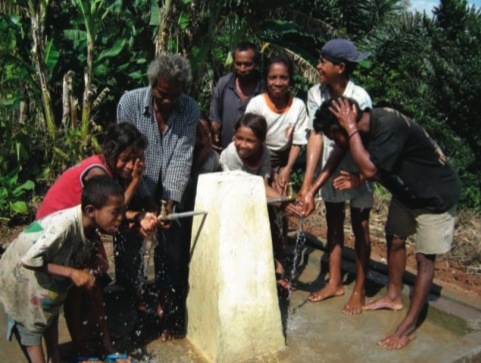Strengthening Civil Society Organizations in Good Governance Processes - Example: Strengthening Village Councils by Transparently Organizing Communal Infrastructure Works in Timor Leste
 |
East Timor ranks as one of the poorest countries in the world with a GDP of US$366 per capita. One in five people live below the international poverty line of a dollar-a-day and there is considerable inequality in levels of poverty, especially between urban and rural areas. Less than 40% of the national demand for the staple crops of maize and rice is produced locally. One crop per season is the norm due to malfunctioning or damaged irrigation infrastructure. Half of the children under five years of age are stunted. The most frequently reported water-borne and related diseases; skin diseases (over 40%) and diarrhea (around 25%).
Infrastructure improves Food SecurityReliable irrigation systems reduce the risks of food production failure in the rural areas. An improvement of rural roads facilitates the exchange of goods between markets and remote communities. Improved water supply and sanitation reduces water borne and transmitted diseases.
Objectives of the ProjectThe ‘Programme to Stabilize Food Security and Promote Peace in Rural Areas of Timor Leste’ (FSP) has operated in four out of 14 districts from January 2003.
|
 |
Basic Assumption for DevelopmentA. Constructive interaction leads to self-confidenceFrequent joint meetings with the local government, village councils, potential work group leaders, community members and FSP technicians helped in clarifying the roles and responsibilities of each stakeholder prior to the physical implementation of the infrastructure project. B. Providing a wider vision of transparency and sound decision makingDuring the preparation phase, the continual explanations on how an infrastructure is constructed and maintained, was essential to achieving transparency. It also helped to broaden the communities’ understanding of the importance of the various steps during the planning, implementation and maintenance.
C. Improving the ability to mobilize human and local resources for community worksDuring the preparation phase, council members and the communities jointly identified local resources, which would contribute to project implementation. Also discussed were the monetary values of contributions by the community, such as local materials and labor days, and locally non-available materials contributed by the FSP. On average, the contribution by communities exceeded 10% of the total monetary value of the rehabilitation. uring the first weeks of implementation, skilled FSP technicians provided intensive coaching to the overseeing council members and work group leaders. Once the responsible persons became familiar with organizing the daily work, the FSP technicians gradually reduced their own involvement. As the council members took upmore of responsibilities for organising worker groups, the collection of local materials, checking progress and quality. The FSP technicians’ role then switched to regularly observing the overall managerial and technical processes and advising the communities on related matters required.
Photo 1: Mobilising human and local resources is essential for community works
D. Village council members become more pro-active in local affairsThe aim of introducing conflict analysis and communication skills to village councils and work group leaders was to develop their understanding of potential threats and provide them with the skills to identify possible solutions. Weak anticipation of potential problems was one root cause of the wide spread hesitancy among the rural population to take on responsibilities for actions, as their fear of failure lead to a lack of responsiveness. Therefore, the practical handling of conflict analysis in real day-to-day cases, identifying the underlying factors and testing possible solutions became a valuable learning experience for all concerned.
E. Time frameExperience gained by the FSP project showed that this type of approach requires a minimum of three years’ commitment by donors and implemen-ting agencies. Strengthening people’s capabilities involves time-consuming learning processes; the ongoing coordination of procedures in relation to the proposed infrastructure; and the recognition that rural people can only join in communal works during the agricultural off-season. Further from the technical viewpoint, physical implementation can be undertaken only during the dry season.
F. Long-term lethargy or inactivity may be difficult to overcomeHistory has left an unfortunate legacy in parts of the rural population. Many communities who have been resettled (either forcibly or otherwise) during the Indonesian occupation to various locations near main roads. These received special attention from the occupier in order to “win their hearts and minds”. As a result, a dependency attitude developed and is still evident among many of these communities.
G. Leaders not supported by their communitiesIt was not always possible to motivate the village councils to become involved in activities, which were designed to enhance their roles, responsibilities and social capacities. Many of them simply wanted the infrastructure scheme to be completed, and saw their role as solely ordering the people to do the work. Community members often did not respond to such ideas or orders from their leaders and remained inactive. |
|
|
What should a project do if the village council
does not agree to capacity building support? The lesson from FSP was to make progress and to defer further assistance to that community and to work with other communities where the leadership is more amenable and progressive. If the necessity for the infrastructure becomes so great, or the leadership becomes convinced by observing the successes of other villages, then the chiefs might, at some later time, seek to again engage with the project. This would involve a new starting point for the engagement through which the stakeholders might agree to the precondition of social capacity building efforts. |
H. Village leaders perceived as acting arbitrarily, which created a sense of futility among the villagersThis situation exists in some communities that were led by strict, authoritarian leaders. In fact, the Timorese tend to classify villages as being good or difficult. The perceived quality of the village population is associated with the village chief’s attitude: if he is a ‘good’ and responsive leader, then it is easy to interact with the villagers. If the chief has an image of being ‘difficult’, then it takes a considerable effort to get the people’s involvement.
I. Competing demands on village leadersVillage chiefs have dual roles: The community sees them from a traditional viewpoint and requires them to lead and often take care of their daily matters. Additionally the chief is also now an official part of the government structure, and is expected to attend official functions. Further due to the still somewhat feudalistic system, the chief is the one and only entry point to the community for the departments of government services, as well as for other development organizations. Therefore, chiefs are often preoccupied with attending other administrative and technical trainings, governmental and church meetings, to which they are invited or required to attend.
Map 1: Overview of Baucau and Viqueque (Source: Google Earth)
J. Basic Good Governance Structures are essentialThe situation has begun to improve slowly with the establishment of the village councils, which were only incorporated into the local governance system in 2005. Having council members available, in theory enables the chiefs to either share or delegate responsibilities. However, due to the still limited capability and understanding of respective roles, it will take some time until sharing of responsibilities is a habit of professional acting. Being aware of the many functions of village chiefs from the outset, FSP directly took up the challenge to involve this new structure of village councils into organizing the project’s infrastructure rehabilitation works. Thereby, it assisted the councils and chiefs in learning and experiencing their roles through practical activities and training. |
|
 |
Seven Steps Towards Transparency
Step 1: Identify communities to be supportedIn selecting locations for infrastructure rehabilitation activities that would be suitable for support, the following basic principles were applied:
Step 2: Identify the infrastructure needs in the target areasThrough improved coordination: In order to assess the support requested by the communities, discussions were held with local organizations that might be affected by the proposed infrastructure project:
When these steps were completed successfully, the organizational structure of the managing partners was set up:
Step 3: Screening of the community’s readiness to engage through socializationA second public meeting with the whole village and led by the village councils clarified the implementation of the project works and:
Step 4: Detailed technical and organizational needs assessmentA technical survey aimed at identifying the proper locations for the proposed infrastructure schemes, there technical requirements, anticipated time frame for completion and cost estimates were prepared. The responsibility for the technical survey was with the FSP technicians. They were supported by the village council members and identified work group leaders in carrying out the survey. At the same time they trained them in identifying potential technical problems that might come up during construction. Involving these people helped to ensure that the entire community better understood why all these activities were necessary.
Step 5: Carry out capacity building supportOn-the-job capacity building was carried out gradually during preparation and physical implementation:
Technical trainings: Workers underwent trainings on technical subjects, such as in construction techniques and maintenance to avoid deviation from technical standards, such as:
Step 6: Mid-term evaluations and focusRegular joint progress evaluations served to identify either technical or social matters that might be hampering smooth implementation of rehabilitation projects. The managing council members carried out this monitoring. Their findings were discussed with FSP technicians, who also guided the councils towards potential solutions. Further focus was given to:
Step 7: Support village council members to participate in activities beyond the rehabilitation worksUpon completion of the physical implementation, the village councils were advised to seek formal recognition of the technical standards achieved. This was usually undertaken and issued by for example public works departments, irrigation departments or, in the case of clean water, by water and sanitation services. The community’s effort thereby received formal recognition, and the village councils learned about the services that the respective departments could offer in case of future maintenance needs.
Achievements and ImpactThe activities provided strong evidence that constructive interactions between village authorities and community members could be achieved, and that village councils could become increasingly pro-active. A comparison of infrastructure works that were implemented with and without attention to social capacity issues showed that:
Photo 3: Better access to clean drinking water improved the life in the communities
|
 |
Centro Desenvolvemento Empresal Regiao Baucau (2006), Materia Trainamento Lider Lider-ansa GTZ - FSP, Anne-Madeleine Bau (2003): Nutrition Baseline Survey Baucau and Viqueque, Timor Leste GTZ – FSP, Domingos Pinto and Sonia Moreira (2007); Laporan Akhir Kegiatan Infrastruktur Baucau dan Viqueque 2003-2007 GTZ – FSP, Domingos Pinto and Sonia Moreira (2007), Guideline Actividade Infrastrutura Pro-grama Siguransa Aihan Baucau ho Viqueque 2003-1007 GTZ – FRCS Project Team Caucasus: Practicioner´s Guide: Strengthening Civil Society Organi-zations in Good Governance Processes |

